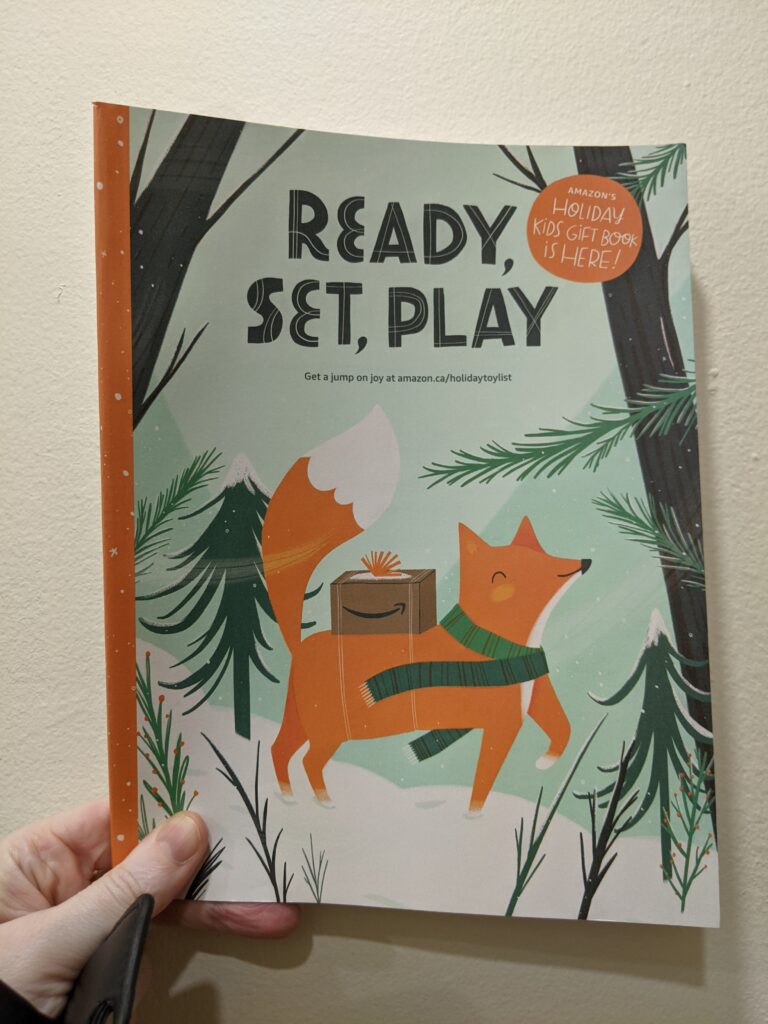by Kyla Winchester
A couple weeks ago I received a holiday gifts flyer. This in itself is very unremarkable; after all, my newspaper always becomes heavy with shopping-related advertising as we approach December. There are toy catalogues, electronics flyers, car ads, jewelry, etc., etc.
However, this was a flyer with a twist: it was from Amazon.
Amazon…is sending a print flyer? To presumably hundreds of thousands of addresses, at least? Amazon, one of the world’s biggest internet ‘stores’, actually design, printed and mailed a catalogue for their online wares?

Yes, indeed. I only noticed it this year but it looks like they’ve been doing it for a while. As someone who works at a fundraising agency where integrated campaigns are championed, I find this extremely illuminating.
What does this indicate, to me? Here are some thoughts.
Print isn’t dead
To paraphrase Mark Twain, reports of the death of print have been greatly exaggerated. Yes, magazine and newspapers are offering digital subscriptions; yes, website, social media and email mean print and advertising are no longer the only path to new supporters; yes, digital is an important element—or even a necessary element—of every campaign. But print isn’t dead.
Anecdotally, we’ve seen direct mail seeing great returns. During the height of pandemic lockdowns, many returned to more traditional forms of media, watching more good ol’ TV (the big screen in your living room) and checking the mail more often out of sheer boredom. Digital can’t compete with print’s “stickiness”: banner ads disappear in seconds, emails get buried withing hours, but a catalogue or a DM premium can hang around for weeks. Depending on the marketing strategy and the ask, print can be far more effective than digital.
Multichannel is the way to go
I truly believe this, but give me a moment to explain why:
- The cost to expand a campaign to include other channels is minimal. If you’re already investing in developing the strategy and refining the copy and design, adding a printed item is very affordable. And vice versa—if you’re creating a direct mail campaign or a print ad, turning that into an email or social post is very low-cost.
- No charity has 100% of supporter email addresses. No social account includes 100% of supporters. And same with mail: if you’re only communicating a matching gift to direct mail recipients, you’re missing out on sharing that message with followers or subscribers who haven’t yet given.
The cost-per-impression decreases as you add channels to the mix. It’s easier and cheaper (and less annoying for your supporters) to reach more eyeballs on another channel than to try to (repeatedly) reach every last person via SMS or email. So an integrated ask makes sense, for outlay and return on investment.
Even digital-first benefits from integration
Let’s go ahead and assume Amazon’s marketing team know what they’re doing. Amazon* has always been an online company, and we can assume that their budget and market dominance means they can afford the best and brightest—and can also afford to invest in determining the most effective mix of advertising channels to attain their goals. They have a very robust acquisition and renewal machine (ask anyone who has tried to cancel Amazon Prime, their free-shipping membership with streaming benefits) which they have had many years to refine.
Given all that, I think we can conclude Amazon is sending out print flyers because it works. Whatever the cost to design, print, and deliver all these flyers, it must presumably be outweighed by the sales they drive.
All this to say: integrated campaigns are more effective than print-only or digital-only. Amazon wouldn’t be doing it unless they had good reason to believe it's true.
*I have no love for billionaires or companies that profit from under-paying employees and taxes; and I don’t wish to promote such people or companies in any way. However, it was in fact a flyer from Amazon.
